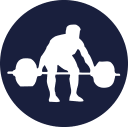

Para Powerlifting
Powerlifting for athletes with visual impairments originated in the early 1980s. Powerlifting comprises three lifts: the squat, the bench press, and the deadlift. In competition, athletes are categorised by gender, age and bodyweight. Powerlifting is great for building strength, skill and mental resilience.
An Overview of Para Powerlifting
How Do I Get Involved?
Many individuals get started in powerlifting through strength training and gradually increasing the amount of weight they can move. Powerlifting gyms provide an environment where anyone can learn to lift more weight and personal training or group classes can help you work on your lifting form.
Progression
Powerlifting is one of the few sports where a visually impaired athlete can compete on an equal basis against sighted competitors, so look out for local powerlifting competitions.
The International Blind Sports Federation (IBSA) Powerlifting follows the same rules as the sighted version of the sport. IBSA regularly host competitions for athletes with visual impairments, including world and regional championships. For more information, visit the IBSA website.
Classification
Sight classifications are important to ensure fair and equal competition. Success at competitions should be defined by an athlete's skill and ability, not their impairment. The sight classifications should give all athletes the confidence that they are competing against others equally.
For more information and to download an application, visit: https://britishblindsport.org.uk/educationandresearch/classifications/

